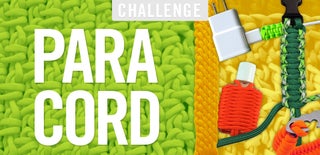Introduction: BirdSaver
Watching the birdfeeders outside our window is a relaxing pastime, but the birds themselves are very precious to my wife and I. This is why it was so concerning to us when a Pine Grosbeak crashed into the glass after being spooked (don't worry, after 45 minutes of rehab in a straw-filled bucket, she made a complete recovery). I immediately began researching methods of deterring birds from future window collisions.
To my surprise, I found nothing on Instructables that addressed this important need. That is when I found this sensible method called the Acopian BirdSaver with a simple Google search. The inventor of this method sells his invention on the website, but also encourages others to make their own (obviously the protection of our winged-friends trumps the monetary value of his device). I set about to make my own, and spread the word.
Step 1: It's a Figure-8 . . . Knot!
The concept here is simple: suspend paracord on the outside of the window, keeping each strand 3.5 - 4.25" (9 - 11cm) apart. The idea being that birds won't fly between objects of that proximity.
Materials List:
-1/8" Paracord
-Cedar Strip (or any board)
-Screws
-Brackets (optional)
-Beads (also optional)
I started with a piece of cedar trim. It was a cut-off and happened to be long enough to cover the section of window that was unscreened. I did some crude math and figured 3.75" spacing would give me even distribution, and marked them with a pencil. I tied a figure-8 knot with the paracord for a stopper and measured what size of drill bit I'd need to counter-sink it. I came up with a 5/8" spade bit. I first drilled the larger of the holes, setting them about halfway through the board, then came back and drilled all the way through with a 1/4" bit.
Step 2: Assemble
The height of my window is 43", so I tied my knots, then measured lengths of paracord 48" to give some breathing room (we'll trim them up later while they're hanging). I cut the ends at the base of the knots, and used a lighter to melt the frayed cord. I needed a way of hanging the board. I could've just punched some screws at either end, but I opted to use some tiny brackets I had laying around.
Step 3: Hang It
The cedar hanger is mounted with 2 screws, one at each end, through the top of the bracket. The wooden round beads are from a massage device and the squares are napkin holders (I think), all purchased in a second-hand store. The purpose of these is to keep the paracord taught, to stop the strands from swaying too much in the wind, and to look cool; they are completely optional. The beads are suspended on the paracord using another series of figure-8 knots.
Step 4: Enjoy
The device works great, but probably isn't for everyone. Although the paracord doesn't impede the view, I can see where dangling ropes from a picture window could be an eyesore. There is an alternative to paracord; using monofilament fishing line supposedly is almost as effective. The strands need to be spaced at 3 inches apart, and need to be hung 5 inches from the window pane. However, based on peer-reviewed experiments, the paracord method remains the safest and most reliable method to protect birds from window collisions. As always, questions and comments are welcome and encouraged. Thanks for the interest and help save our birds.

Participated in the
Paracord Challenge

Participated in the
Protected Contest

Participated in the
On a Budget Contest













